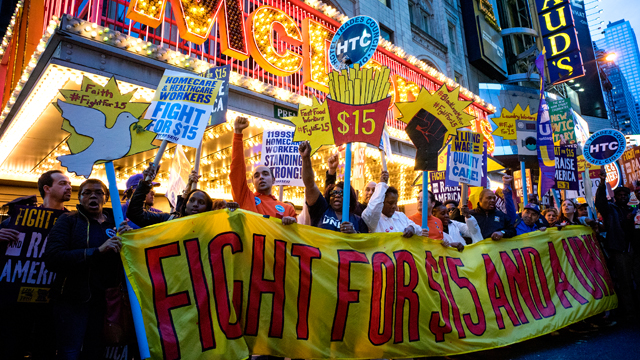This post first appeared at TalkPoverty.

Protestors pause near a McDonald’s restaurant in Times Square during a rally and march in New York, Wednesday, April 15, 2015, as participants, fast food workers and union members, call for a $15 minimum wage. (AP Photo/Craig Ruttle)
On April 15, 2015, low-wage workers across the US and around the world once again waged a flash strike intended to capture the attention of employers and policy-makers who control their wages. Protesters didn’t spend their limited monies to ride buses, trains or planes to Washington, DC where their actions might or might not have attracted much media attention. Instead, they took to the streets where they live and labor — in 200 US cities and across the United Kingdom, Brazil, India, Italy, Bangladesh, Japan, and 30 other countries.
At a time when multi-national corporations are 50 of the world’s largest 100 economies, this movement has had to be both intensely local and expansively global. Less than three years ago, the grassroots campaign for a living wage began in scattered Thanksgiving protests by New York City fast food workers and Los Angeles Wal-Mart associates. This year’s protests are the largest and most global labor actions ever mounted.
From Manila to Manhattan, workers are showing the face of the 21st century labor movement. On Wednesday, Fight for $15 protests gleefully short-circuited the “90-seconds-a-customer” service rule at McDonald’s. In Seoul, workers staged mock trials of Ronald McDonald for wage theft; in Manila they blocked streets and malls with singing and dancing flash mobs. Protesters uploaded clips of their actions onto YouTube and Facebook. They Instagrammed photographs and sent fast-disappearing Snapchat messages about where to meet for the next action. In this era of social media, organizers no longer need to worry about press coverage — or at least they don’t’ need to worry as much.
In many parts of the world, this April’s worker protests offered local labor activists a chance to highlight their own struggles. In Brazil, unions called a general strike for April 15, in solidarity with workers in other countries and to protest recent legislative encroachments on labor rights. In Bangladesh, garment workers have, in the last two years, built a global movement forcing scores of major clothing labels to sign an accord allowing Bangladeshi unions to inspect garment factories for safety violations. On April 24, the 2nd anniversary of the Rana Plaza collapse — which killed 1,134 garment workers and injured thousands more — Bangladeshi workers will lead a global day of action to pressure brand companies to pay damages to victims and their families. Garment union leader Kalpona Akter and Rana Plaza survivor Mahina Begum were among 28 arrested last month in New Jersey for bringing that demand in person to corporate executives of The Children’s Place. This month, Benetton finally agreed to pay damages.
The living wage issue is also as local as it is global. Fifty-eight percent of the US jobs created since the 2008 crash do not pay enough for workers to live on. Local workers’ protests blocked sidewalks in New York, Chicago and Los Angeles, where immigrant restaurant employees endure 70-hour weeks and wages that are even lower than the pitiful federal minimum of $2.13 an hour for tipped employees. Home health care workers, too, have begun to step out of the shadows where they care for fragile clients. How they find the time to organize is anyone’s guess, given that some work as many as 120 hours a week. The fight for a living wage has even started to interrupt classes on American college campuses, where three-quarters of professors are now contingent contract laborers and one in four earns so little that they require public assistance to survive. Adjunct professors are not quite as hard-pressed as the country’s fast food workers, 52 percent of whom receive public assistance; home-health care workers, 48 percent of whom need to turn to cash, food or medical aid programs; or child care workers, 46 percent of whom also need government aid. Still, a majority of college professors are now employed on temporary contracts, shuttling between campuses, teaching upwards of 12 courses a year, earning between $20,000 and $25,000 annually. They are truly low-wage workers, and they feel a real bond with fast food workers, child-care workers, and providers of at-home health care.
It is extraordinary for workers as different as these to band together. We have reached a point where even an advanced degree no longer guarantees a path out of poverty.
Perhaps that is why the movement has already had its successes. City officials from Providence to Seattle have passed municipal minimum wages that are significantly higher than federal or state requirements. Voters in red states as well as blue cast their ballots last November for increased state minimum wages. And, most recently, the world’s largest corporations have shown signs of recognition that they must raise wages a little bit — if only for appearances.
Still, fair wages are not all that this movement seeks. Low-wage workers — in the US and abroad — are demanding the right to unionize without employer retribution. That demand has met fierce opposition from employers of all sizes.
Low-wage workers have few options for exerting power over employers. One is “hitting them in the pocketbook” — staging protests that disrupt business. Another is leveraging the power of government on the side of workers: Large unions such as The Service Employees International Union (SEIU), representing health care workers in Connecticut — and small worker’s groups such as the Laundry Workers Center United (LWCU), representing restaurant employees in New York City — have recently filed suit for wage theft, sexual harassment, and violation of federal minimum wage and maximum hours laws.
Increasingly, employers have filed their own suits — using the Racketeering and Corrupt Organization Act (RICO) — to try to hobble union campaigns. RICO suits filed solely to hinder labor organizing violate the spirit of the original legislation, passed in 1970 to facilitate prosecution of organized crime and to limit mobsters’ ability to take over labor unions. But, from the perspective of workers, such suits only inspire more activism. As Virgilio Aran recently told me about the RICO suit filed against organized employees of Liberato restaurant in the Bronx: “For every suit they file against us we will organize 1000 times harder.”
Just a few short years after it was declared dead and almost buried, the labor movement has come roaring back. Behind it has come a powerful bipartisan sentiment that it is time to pay workers something better than poverty wages. In the last few decades we have regressed to the wealth stratification of the 1890s. Perhaps now we can return to the majority view of the 1930s that unions have a positive role to play in a stable, healthy economy.
The views expressed in this post are the author’s alone, and presented here to offer a variety of perspectives to our readers.


